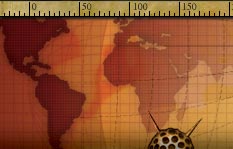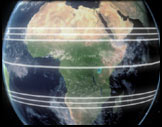 |
 |
 |
 |
|||||||||||
The Story Of... Latitude and Climate Daily life on our planet is governed by fundamental universal forces, far beyond our control. A chance product of our distance from the Sun, and the physical properties of the earth itself, factors like latitude and climate have played a central part in the grandest patterns of human history.
Latitude expresses any distance north or south of the Equator, in degrees between 0 and 90, and measured from a point of origin at the center of the earth. Lines of latitude are significant not just for global navigation – but, more fundamentally, because they reflect the changing angle of the sun in respect to the earth. This alone determines day length, seasonality, and to a large extent, climate. For example, a person standing anywhere between 23.25 degrees north, and 23.25 degrees south of the Equator will – at some point during the year – be standing directly perpendicular to the rays of the Sun. In this region there is hardly any fluctuation in day length or seasonality, apart from a tendency towards cooler, drier weather when the earth tilts away from the sun (wintertime), and hotter, wetter weather when the earth tilts towards the sun (summertime). As we move north or south of the tropics, and farther away from the Equator, the difference between hours of daylight, compared to hours of nighttime, will start to increase. At forty degrees, for example, with the earth tilting away from the sun, the day will be much shorter than the night (wintertime). If the earth is tilting towards the sun, the day will last much longer than the night (summertime). Winter and summer in these parts of the world cycle between much broader climatic extremes than at the Equator – winters are very cold, dark, and often wet; summers are very hot, bright, and often dry. And in these latitudes there are also transitional phases, or seasons, known as autumn and spring, where the hours of nighttime and daytime reach momentary equilibrium. In these so-called temperate zones, seasonality has a major impact on which plants, animals, and even diseases can thrive. Beyond 66 degrees north or south of the Equator, in the so-called arctic regions, the seasons reach their most dramatic extremes. In the summer, the sun never sets, whilst in the winter, the sun never rises. The temperature here remains cold all year round and in such inhospitable conditions very few plants or creatures can thrive. Any two points east or west of one another, which share the same latitude, will also share the same day length, and therefore – by and large – the same climate. Plants and animals which thrive at a given latitude, will tend to thrive at the same latitude anywhere else on the planet – either north or south of the Equator. So, if there is an easy east/west overland migration route for those crops or animals, they will tend to successfully export themselves beyond their point of origin. However, it is very unusual for plants and animals which thrive at one latitude, to be able to survive at dramatically different latitudes. Successful migration north or south is extremely rare, because moving through different latitude zones means moving through dramatically different climates, day lengths, and environmental conditions. In this context, latitude has had massive implications for the grandest patterns of history, seen most clearly in the differing fortunes of Eurasia, Africa and the Americas. Where to next? Get the "Story of..." Shape of the Continents or Cities and Civilizations. |
|||||||||||
 |
|
| Variables CROPS - Wheat - Rice - Corn - Sorghum ANIMALS - Cattle - Goats - Sheep - Pigs - Llamas - Horse - Zebra GERMS - Smallpox - Malaria TECHNOLOGY - Steel - Writing GEOGRAPHY - Latitude and Climate - Shape of the Continents - Cities and Civilizations |
|
